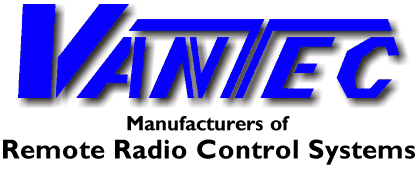| Jump to #KeyKoder Technology Early 1980's Radio/Control
transmitted each channels servo position as an analog pulse width that ranged from 1-2
milliseconds. The pulses were transmitted as a continuously "on" Radio Frequency
energy carrier with their beginning and end marked by Amplitude Modulating
the RF carrier "off" for 0.35 ms. The channels were sent sequentially with the
.35ms end mark of one serving as the beginning mark of the next channel. A special long
"Framing" pulse delineated the beginning of the channel series. The receiver
used the marks to determine the channels, otherwise the receiver was dumb. Any noise or
interference in the "air" was interpreted as a marker and mis-commanded the
servos; the receiver couldn't tell the difference. Later FM versions in the early
'90's suffered the same problems.
The Pulse Code Modulation
receiver is smart; it contains a microprocessor. By clever
structuring of the servo commands using mathematics and precise timing PCM facilitates
accurate reception even with severe noise or interference.
It begins in the transmitter by
conversion of each joystick position into a 10 bit digital word plus the extra bits to
enable the receiver to mathematically verify the word. The next trick of PCM is to
compact this data representing 1024 servo positions per channel into the FCC specified
radio bandwidth while maintaining responsive "real time" control to fly a
helicopter. The PCM data is transmitted synchronously; each bit has a particular
position in time, within the Frame. The Frame continuously repeats. A precision crystal
controlled clock in the receiver locks onto the transmission to maintain synchronization
with the data bit by bit even during major signal drop outs. Thus the receiver can process
data immediately after interference instead of waiting for a Framing pulse.
Received data is evaluated channel by
channel. When the mathematics indicates an error, previously validated channel data that
is stored in the smart microprocessor is substituted. If an error
persists then failsafe servo operations previously specified by the operator are initiated
until accurate commands are again received. The microprocessor
converts the proper data into pulse widths to command the servos. No more servo jitters!
Futaba's PCM1024 scheme
gives 8 channels of 10 bit resolution. Other competitive systems lack Futaba's
sophisticated data compaction scheme and so must limit the resolution of some channels to
8 bits, which is 1/4 as accurate, as a trade-off to satisfy the "real time" data
rates required.
The first add-on channel KeyKoder product was sold by VANTEC in 1981. We have
improved the product several times since. In this fresh new design we deciphered Futaba's
PCM1024 format to capitalize on it's reliability for secure robot applications. The on-off
added-channel KeyKoder described in this paper is fundamentally a 32 channel KeyKoder
device. In this new technology up to four KeyKoder type devices
can be piggybacked on one PCM1024 servo channel. Four of these
devices therefore yields 128 on-off functions through a single servo channel.
Other KeyKoder device functions are available, for example the transmitter ID and
high security function is incorporated into the KIK29, KIK44 and
other "industrial strength" products, as well as Key-on/Key-off operation.
Two other interesting applications for KeyKoder Technology is the addition of more
servo channels with 8 bit resolution, and a slow speed data channel for radio controlled
advertising blimps or for "calling" special robot functions implemented by an on
board computer.
VANTEC is interested in your special commercial or industrial control application
using KeyKoder technology; give us a call at (541) 471-7135 |
